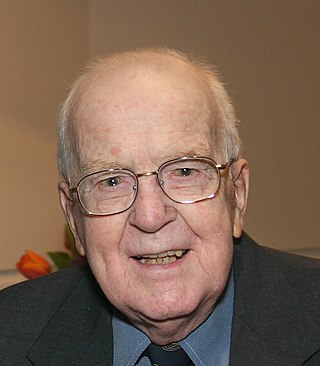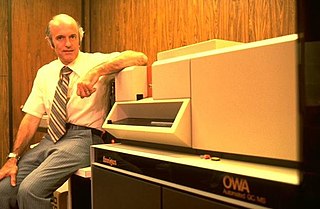
Henry Cary was an American engineer and the co-founder of the Applied Physics Corporation, along with George W. Downs and William Miller. The Cary 14 UV-Vis-NIR and the Cary Model 81 Raman Spectrophotometer were particularly important contributions in scientific instrumentation and spectroscopy. Before starting Applied Physics, Cary was employed by Beckman Instruments, where he worked on the design of several instruments including the ubiquitous DU spectrophotometer. Howard Cary was a founder and the first president of the Optical Society of Southern California.

JEOL, Ltd. is a major developer and manufacturer of electron microscopes and other scientific instruments, industrial equipment and medical equipment.
Pittcon Editors’ Awards honoured the best new products on show at the Pittsburgh Conference on Analytical Chemistry and Applied Spectroscopy, or Pittcon, for 20 years from 1996 having been established by Dr Gordon Wilkinson, managing editor of Analytical Instrument Industry Report. On 8 March 2015, the event returned to the Morial Convention Center in New Orleans and this was the last occasion when the awards were presented.
The Williams–Wright Award is an award that honors extraordinary or outstanding work in spectroscopic measurements while working in an industrial setting. The award has been given by the Coblentz Society annually since 1978 with the Awardee being selected by a committee of leading spectroscopists. The Award citations reads, "The Coblentz Society proudly presents the Williams–Wright Award to --- for his/her outstanding contributions to the Field of Industrial Spectroscopy."
Joshua Coon is a professor of chemistry and biomolecular chemistry and the inaugural holder of the Thomas and Margaret Pyle Chair at the University of Wisconsin–Madison, and an affiliate of the Morgridge Institute for Research.
The Eastern Analytical Symposium (EAS) and Exposition is an American organization that sponsors a Symposium and Exposition generally held in Princeton, New Jersey, every November. The Symposium is attended by over 2000 scientists and typically contains several hundred papers by the world's leading authorities on analytical chemistry.

Jerome J. Workman Jr. is an American analytical spectroscopist, author, and editor born on August 6, 1952, in Northfield, Minnesota. Jerry Workman Jr. and J.J. Workman are also names he uses for publishing.
The Federation of Analytical Chemistry and Spectroscopy Societies or FACSS is a scientific society incorporated on June 28, 1972, with the goal of promoting research and education in analytical chemistry. The organization combined the many smaller meetings of the individual societies into an annual meeting that includes all of analytical chemistry. The meetings are intended to provide a forum for scientists to address the development of analytical chemistry, chromatography, and spectroscopy.
ChemWindow is a chemical structure drawing molecule editor and publishing program now published by John Wiley & Sons as of 2020, originally developed by Bio-Rad Laboratories, Inc. It was first developed by SoftShell International in the 1990s. Bio-Rad acquired this technology in 1996 and eventually made it part of their KnowItAll software product line, offering a specific ChemWindow edition of their software for structure drawing and publishing. They have also incorporated ChemWindow structure drawing components into their KnowItAll spectroscopy software packages with their DrawIt, ReportIt, and MineIt tools.

The Society for Electroanalytical Chemistry (SEAC) is a scientific society based in the United States which promotes advances in both basic and applied research in electroanalysis. Founded in 1984, SEAC has members at all education levels from academia, industry, and government. It provides a platform for the exchange of ideas and recognition of achievement in the electroanalytical community.
Isao Noda is a chemical engineer whose research has focused on polymer science and spectroscopy. He holds ninety patents granted in the United States and the EU, has published over three hundred articles, co-authored three books, and received a number of industry-wide awards and recognition for his contributions to his fields of research.

The Pittcon Heritage Award recognizes "outstanding individuals whose entrepreneurial careers shaped the instrumentation and laboratory supplies community." The award is jointly sponsored by the Pittsburgh Conference on Analytical Chemistry and Applied Spectroscopy (Pittcon) and the Science History Institute. The award is presented annually at a special ceremony during Pittcon.

Foil Allan Miller was an American chemist and philatelist best known for his work in infrared and Raman spectroscopy. He was head of the spectroscopy division of the Mellon Institute and later professor and head of the spectroscopy laboratory at the University of Pittsburgh. Among other publications, he co-authored the books Course Notes on the Interpretation of Infrared and Raman Spectra (2004) and A Philatelic Ramble Through Chemistry (1998).

Robert Emmet Finnigan was an American pioneer in the development of gas chromatography–mass spectrometry equipment (GC/MS). Finnigan founded the Scientific Instruments Division of Electronic Associates, Inc., producing the first commercial quadrupole mass spectrometer in 1964. He then formed Finnigan Instruments Corporation to combine a computer system with a quadrupole mass spectrometer and gas chromatograph. Finnigan's GC/MS/computer systems are used to detect and identify trace organic compounds, making them important instruments for the monitoring and protection of the environment. They were adopted by the United States Environmental Protection Agency as a standard instrument for monitoring water quality and were fundamental to the work of the EPA.
Renã A. S. Robinson is an associate professor and the Dorothy J. Wingfield Phillips Chancellor's Faculty Fellow in the department of chemistry at the Vanderbilt University, where she is the principal investigator of the RASR Laboratory.

Gary M. Hieftje is an analytical chemist, Distinguished Professor, and the Robert & Marjorie Mann Chair of Chemistry at Indiana University in Bloomington, Indiana. Gary M. Hieftje received his A.B. degree at Hope College in Holland, Michigan in 1964, and his PhD from University of Illinois at Urbana–Champaign in 1969. In 1969, he started his career in teaching and research at Indiana University. Hieftje was named a Distinguished Professor in 1985, and entered emeritus status in 2018. As of 2018, Dr. Hieftje has been involved in over 600 publications.
Karen Jane Faulds is a Scottish academic and Professor of Analytical Chemistry at the University of Strathclyde. She develops surface-enhanced Raman spectroscopy (SERS) for bioanalysis, and has won several awards for her research, including the Coblentz Society Craver Award.
Kirsty Elizabeth Helena Penkman is a biochemist and geochemist known for her research in biomolecular archaeology, the use of ancient DNA, amino acid dating, and other biomolecules in order to date fossils and learn about the world as it was in prehistoric times. She is a reader in chemistry at the University of York.

Parastoo ("Parry") Hashemi is an Iranian-British neural engineer at Imperial College London and the University of South Carolina.
Paul William Bohn is an American chemist who researches molecular nanotechnology. He is a fellow of the American Association for the Advancement of Science, Royal Society of Chemistry, and Society for Applied Spectroscopy, as well as a co-editor of the Annual Review of Analytical Chemistry.










